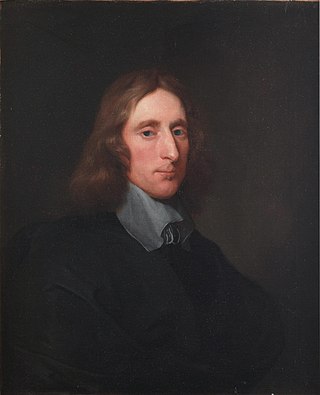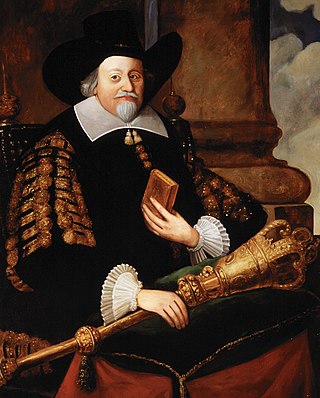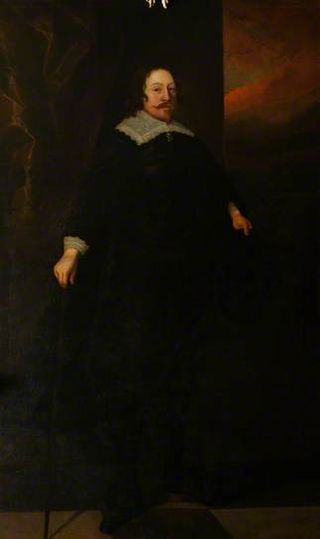Related Research Articles

The Commonwealth was the political structure during the period from 1649 to 1660 when England and Wales, later along with Ireland and Scotland, were governed as a republic after the end of the Second English Civil War and the trial and execution of Charles I. The republic's existence was declared through "An Act declaring England to be a Commonwealth", adopted by the Rump Parliament on 19 May 1649. Power in the early Commonwealth was vested primarily in the Parliament and a Council of State. During the period, fighting continued, particularly in Ireland and Scotland, between the parliamentary forces and those opposed to them, in the Cromwellian conquest of Ireland and the Anglo-Scottish war of 1650–1652.

The Long Parliament was an English Parliament which lasted from 1640 until 1660. It followed the fiasco of the Short Parliament, which had convened for only three weeks during the spring of 1640 after an 11-year parliamentary absence. In September 1640, King Charles I issued writs summoning a parliament to convene on 3 November 1640. He intended it to pass financial bills, a step made necessary by the costs of the Bishops' Wars against Scotland. The Long Parliament received its name from the fact that, by Act of Parliament, it stipulated it could be dissolved only with agreement of the members; and those members did not agree to its dissolution until 16 March 1660, after the English Civil War and near the close of the Interregnum.

Richard Cromwell was an English statesman, the second and final Lord Protector of the Commonwealth of England, Scotland and Ireland and the son of the first Lord Protector, Oliver Cromwell.

The Rump Parliament was the English Parliament after Colonel Thomas Pride commanded soldiers to purge the Long Parliament, on 6 December 1648, of those members hostile to the Grandees' intention to try King Charles I for high treason.
The Committee of Safety, established by the Parliamentarians in July 1642, was the first of a number of successive committees set up to oversee the English Civil War against King Charles I, and the Interregnum.

Francis Rous, also spelled Rouse, was an English politician and Puritan religious author, who was Provost of Eton from 1644 to 1659, and briefly Speaker of the House of Commons in 1653.

George Booth, 1st Baron Delamer, was an English landowner and politician from Cheshire, who served as an MP from 1646 to 1661, when he was elevated to the House of Lords as Baron Delamer.

The English Council of State, later also known as the Protector's Privy Council, was first appointed by the Rump Parliament on 14 February 1649 after the execution of King Charles I.

The Third Protectorate Parliament sat for one session, from 27 January 1659 until 22 April 1659, with Chaloner Chute and Thomas Bampfylde as the Speakers of the House of Commons. It was a bicameral Parliament, with an Upper House having a power of veto over the Commons.

Honiton was a parliamentary constituency centred on the town of Honiton in east Devon, formerly represented in the House of Commons of the Parliament of the United Kingdom. It sent members intermittently from 1300, consistently from 1640. It elected two Members of Parliament (MPs) until it was abolished in 1868. It was recreated in 1885 as a single-member constituency.
John Arrowsmith was an English theologian and academic.
Events from the year 1659 in England.

Sir Lislebone Long (1613–1659) was an English landowner and politician who was briefly Speaker of the House of Commons.
Sir Robert Reynolds (1601–1678) was an English lawyer and Member of Parliament (MP) Long Parliament who took the parliamentary side on the outbreak of the Civil War. He served as Solicitor General and Attorney General during the First Commonwealth and supported the restoration of the Monarchy during the Second.

Chaloner Chute I of The Vyne, Sherborne St John, Hampshire, was an English lawyer, Member of Parliament and Speaker of the House of Commons during the Commonwealth.
William Purefoy was an English politician who sat in the House of Commons of England variously between 1628 and 1659. He supported the Parliamentary cause in the English Civil War and was one of the regicides of King Charles I of England.
John Clarke, also known as John Clark, John Clerk, and John Clerke, was an English politician and Justice of the Peace who sat in the House of Commons from 1653 through 1660, and was a colonel in the Parliamentary army between 1651 and 1659.
Robert Shapcote, JP was an English lawyer from Devon and four times Member of Parliament for Tiverton in 1646–1649, 1654, 1656 and 1660. He sat in the Irish House of Commons for the borough of Wicklow from 1661 to 1665 and was Solicitor-General for Ireland and twice briefly Attorney-General for Ireland. He fought in the Parliamentary army in the Civil War.
References
- ↑ Parliamentary Papers. H.M. Stationery Office. 1878.